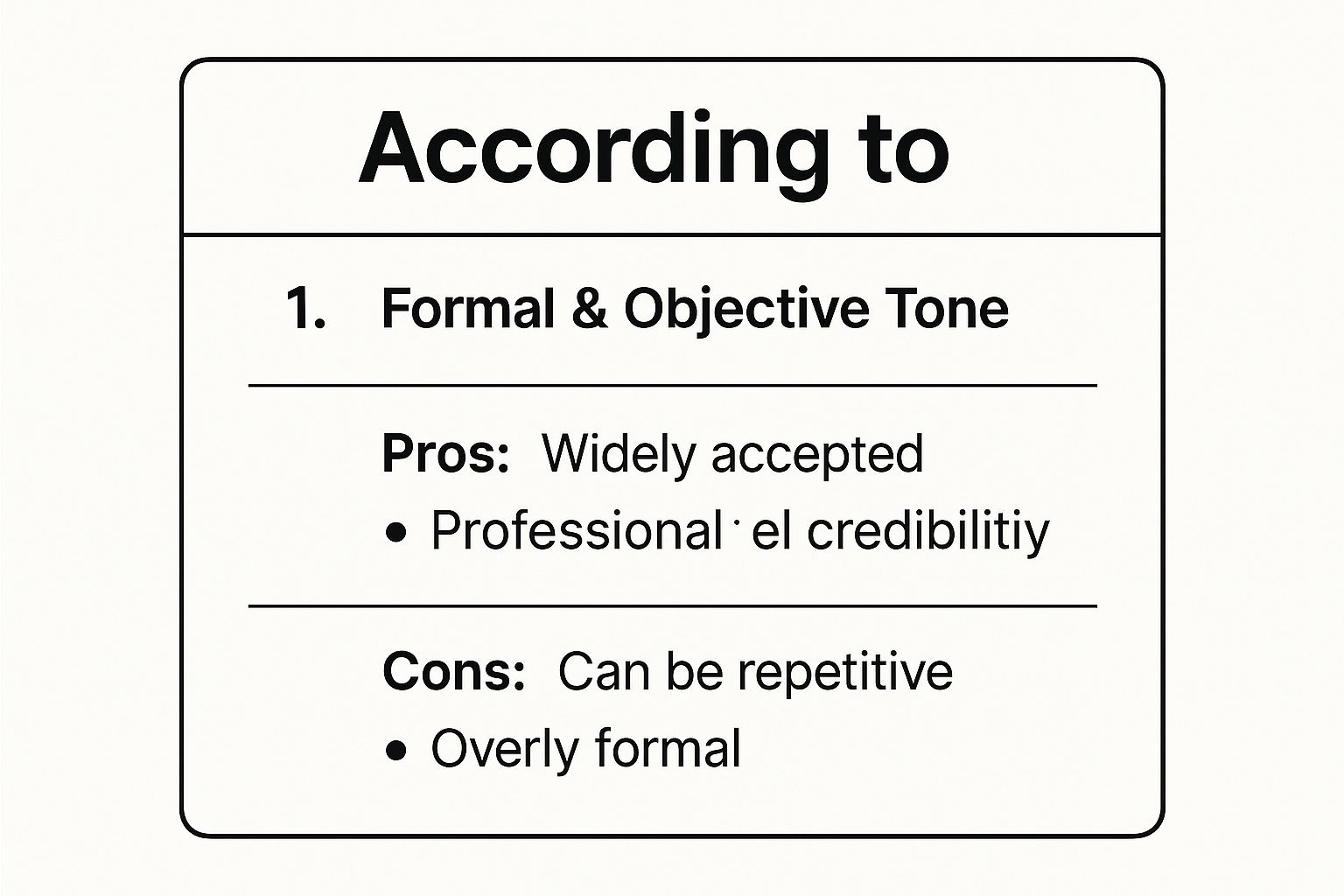7 Fresh Ways to Find Another Word for According | 2025 Guide
- Janis Kolomenskis
- Jul 6
- 12 min read
Welcome to your definitive guide on elevating your professional writing! We've all been there, stuck in a loop, using 'according to' repeatedly until it loses all its impact. In formal reports, business emails, and even academic papers, varying your language is not just about style; it's about precision, tone, and authority. The right phrase can transform a simple statement into a powerful, evidence-backed assertion. Overusing one phrase can make your writing feel flat and uninspired, but finding the perfect substitute, another word for according, can make your message resonate with clarity and confidence.
This guide is organised to move beyond a simple thesaurus list. We will dive deep into seven distinct alternatives, exploring the subtle nuances of each. You will learn not just what to say, but when and why to say it, with practical examples and contextual tips that you can implement immediately. Let's revitalise your vocabulary and make every word count
1. According to: The Gold Standard of Attribution
Before we dive into the exciting world of alternatives, let's pay homage to the classic itself: according to. Think of it as the foundation upon which all other forms of attribution are built. Its power lies in its crystal-clear function: to objectively and formally cite a source of information. When you use "according to," you're drawing a distinct line in the sand, separating your own voice from the information you're presenting.
This simple phrase is a powerhouse of credibility. It instantly signals to your readers, whether they're potential hires reviewing a company report or stakeholders analysing market data, that what follows is not your opinion but a fact or statement originating from a specific, named source. This transparency is indispensable in professional communication, from formal reports and academic papers to legal documents and client presentations. While our goal is to find another word for according to, we must first respect its role as the undisputed gold standard.
When to Stick with the Standard
The universal recognition of "according to" makes it the go-to choice in situations where clarity and authority are non-negotiable.
Citing Official Sources: Use it when referencing data from research institutions, government bodies, or industry-leading publications. * Example: According to the latest figures from the Office for National Statistics, the tech sector grew by 6% last year.
Quoting Expert Opinions: It lends immense weight to your argument when attributing a statement to a recognised expert or leader. * Example: According to our CEO's quarterly address, we will be investing heavily in AI-driven recruitment tools.
For a quick overview, this summary box breaks down the core characteristics of using "according to".

The key takeaway here is the balance between professionalism and potential repetition; its formality is a strength in some contexts but can feel stiff in others, which is precisely why exploring alternatives is so valuable for dynamic business writing.
2. Based on: Building on a Foundation of Evidence
If "according to" is about citing a source directly, then based on is its analytical cousin. This phrase is a superb alternative when you need another word for according to that signals a conclusion drawn from evidence rather than a direct quote. It tells your reader that you've synthesised information from data, research, or feedback to arrive at a logical point. It’s less about repeating what a source said and more about interpreting what the information means.

This distinction is crucial for recruiters and HR managers who must build a business case for their strategies. When you use "based on," you're not just presenting a fact; you're demonstrating your reasoning and showing that your recommendations are grounded in solid analysis. It shifts your role from a simple messenger to a strategic partner, showcasing your ability to connect the dots between raw data and actionable insights. This makes it an incredibly powerful tool for executive summaries, presentations, and strategic proposals where you need to justify a course of action.
When to Build Your Case
"Based on" shines when you need to present conclusions or recommendations that are underpinned by specific evidence. It’s perfect for situations that require a layer of interpretation.
Synthesising Data or Feedback: Use it when your statement is the result of analysing multiple data points, survey results, or feedback forms. * Example: Based on our analysis of exit interviews from the last two quarters, we need to revise our onboarding process to improve early-stage retention.
Presenting Data-Driven Conclusions: It’s ideal for connecting evidence to a logical outcome, especially when pitching a new recruitment strategy or technology. * Example: Based on recent studies showing a 40% faster time-to-hire with AI sourcing, we should pilot a new platform.
The key takeaway is that "based on" frames your statement as a well-reasoned conclusion derived from a foundation of proof. It adds a layer of analytical authority to your communication, making it an excellent choice when you want to persuade your audience with logic and evidence rather than just citing a source.
3. As stated by
When you need to signal that the information you're presenting is a direct quotation or a very close paraphrase from a specific individual or official document, as stated by is your go-to phrase. It carries a level of formality and precision that goes a step beyond the general attribution of "according to". Using "as stated by" implies a direct, verifiable statement, lending an air of officialdom and irrefutability to the information.

This phrase is a powerful tool in your communication arsenal, especially in HR and recruitment where clarity on policies, legal standpoints, and executive decisions is paramount. It tells your audience, whether it's a candidate or an internal team, that what follows isn't an interpretation but the definitive word from a source of authority. This makes it an excellent choice for another word for according when you need to convey finality and exactness.
When to Use This Direct Attribution
"As stated by" is most effective when precision is critical and the source's exact words or position must be emphasised. It’s perfect for reinforcing policies or official announcements.
Communicating Official Positions: Use it when relaying formal decisions from leadership or specific departments. * Example: As stated by the company’s legal team, our new data privacy policy will be implemented on 1st July.
Quoting Authoritative Figures: It adds significant weight when citing a specific expert, leader, or official source, reinforcing the credibility of the information. * Example: As stated by our Head of Talent Acquisition, all new hires will undergo a structured ninety-day onboarding programme.
For a quick reference, this summary box outlines the key characteristics of using "as stated by".
Characteristic | Description |
|---|---|
Formality | High; conveys an official, serious tone. |
Precision | High; suggests a direct quote or close paraphrase. |
Best For | Legal notices, policy documents, official announcements, and quoting authority figures. |
The key takeaway is that "as stated by" provides an extra layer of authority. It removes ambiguity and firmly links the information to its source, making it indispensable in situations where there is no room for misinterpretation.
4. Per: The Corporate Communicator's Choice
When you need a word that is sharp, efficient, and carries an unmistakable air of business professionalism, look no further than per. This powerful little preposition is a favourite in corporate, legal, and technical environments for a reason. It succinctly communicates that an action or piece of information is in direct compliance with a specific instruction, policy, or source.
Using "per" signals a clear, direct link to an established authority or directive. It's less formal than "in accordance with" but more direct and professional than simply saying "because." For HR managers, recruiters, and internal communicators, "per" is the perfect tool for conveying information that is non-negotiable and based on a pre-existing framework, making it an excellent, concise alternative when you're looking for another word for according.
When to Use This Efficient Alternative
"Per" truly shines in internal communications where brevity and clarity are paramount. It cuts through the noise and gets straight to the point, reinforcing that decisions are guided by established rules or directives.
Communicating Directives and Instructions: It is ideal for memos, emails, and internal announcements where you are relaying instructions from leadership or a governing body. * Example: Per the CEO's instructions, all quarterly reports must be submitted by Friday.
Referencing Policies and Procedures: Use it to ground a statement or requirement in official company policy, leaving no room for ambiguity. * Example: Per company policy, all overtime must be pre-approved by your line manager.
Citing Internal Data or Reports: It works perfectly for referencing internal findings or data points in presentations or summaries. * Example: Per the latest engagement survey, our team's satisfaction has increased by 15%.
For a quick overview, this summary box breaks down the core characteristics of using "per".
Aspect | Description |
|---|---|
Primary Use | Citing instructions, policies, or official company communications. |
Tone | Professional, direct, and efficient. |
Context | Best suited for business correspondence, memos, and internal reports. |
Key Benefit | Offers exceptional conciseness and clarity in professional settings. |
Caution | Can sound overly abrupt or bureaucratic in less formal or external contexts. |
The key takeaway is that "per" is a master of efficiency. Its directness is a major advantage for clear internal communication, but be mindful that it can feel too stark for creative or more narrative-driven writing.
5. In accordance with: The Voice of Compliance and Formality
Stepping into the realm of official procedure and legal precision, we find the powerful phrase in accordance with. This isn't just another word for according; it's a declaration of adherence. It signifies that an action or statement is in perfect alignment with a pre-existing rule, standard, law, or decision. It’s the language of compliance, carrying a weight of formality and obligation that commands respect.
When you use "in accordance with," you're communicating more than just the source of information. You are explicitly stating that you are following a directive. This makes it an indispensable tool in contexts where procedure is paramount, such as in legal documents, HR policies, and regulatory announcements. It removes ambiguity and asserts that actions are not arbitrary but are instead guided by established protocols, making it a favourite for institutional and corporate communications.
When to Embrace Formality
This phrase thrives in environments where rules and regulations are the bedrock of operations. It’s your go-to when you need to demonstrate that you are acting in lockstep with a specific guideline.
Communicating Policy and Regulation: Use it to show that company actions are aligned with internal policies or external laws. * Example: In accordance with federal regulations, all new employee data must be securely encrypted and stored.
Executing Official Decisions: It’s perfect for announcing the implementation of a decision made by a governing body, like a board of directors or committee. * Example: In accordance with the board's decision from the last quarter, operations will expand into the European market.
Enforcing Safety and Procedure: In situations involving health and safety, this phrase underscores the seriousness and necessity of the actions taken. * Example: In accordance with established fire safety protocols, the building was evacuated immediately upon the alarm sounding.
The key takeaway is that "in accordance with" is reserved for situations demanding a high degree of formality and a clear link to a governing rule or standard. While it might be too rigid for casual updates, it is the perfect choice for conveying authority and ensuring that all stakeholders understand that actions are being taken by the book.
6. As reported by: The Journalistic Approach
Step into the world of breaking news and official announcements with as reported by. This phrase is a powerful alternative that immediately adds a journalistic flair to your writing. It's the go-to choice when you need another word for according to that specifically points to news outlets, media organisations, or official reports as the source of your information. Its strength lies in its ability to ground your statements in the public domain, suggesting the information is verified and widely disseminated.
Using "as reported by" signals to your audience, such as HR managers reviewing industry trends or tech startups tracking competitor movements, that the information is timely and has been vetted by professional journalists or analysts. This is crucial when communicating about current events, market shifts, or public announcements. It builds a bridge of credibility by associating your communication with established and recognised sources of news and analysis, making your content feel both current and authoritative.
When to Embrace the News Angle
"As reported by" is your best ally when your information comes directly from the press or from formal, public-facing reports. It's perfect for adding a layer of timely relevance.
Citing Media Outlets: Use it when your source is a specific news organisation, from international broadcasters to niche industry publications. * Example: As reported by the Financial Times, a new wave of investment is expected in the renewable energy sector.
Referencing Current Events: It’s ideal for newsletters, company updates, and presentations that touch upon recent developments or breaking news. * Example: As reported by local news agencies, the recent tech conference generated significant interest from international talent.
For a quick overview, this summary box breaks down the core characteristics of using "as reported by".
Characteristic | Description |
|---|---|
Primary Use | Citing news organisations, media, and public reports. |
Tone | Journalistic, authoritative, and timely. |
Best For | Newsletters, industry updates, and current event analysis. |
Key Advantage | Connects your information to established, public sources of information. |
The key takeaway is that this phrase is tailored for sourcing information that is already in the public consciousness. It's an excellent tool for demonstrating that your organisation is well-informed and in sync with the latest industry-specific news and global events.
7. In the words of: Adding a Personal Touch
When you want to move beyond simple attribution and infuse your writing with personality and voice, in the words of is your perfect ally. This phrase acts as a spotlight, shifting the focus from a faceless source to a specific, named individual. It’s a direct and intimate way to introduce a quote or a closely paraphrased statement, signalling to your audience that what follows is not just information, but a personal sentiment or a powerful piece of wisdom.
Using "in the words of" creates a sense of closeness between the speaker and the reader. It’s a storytelling technique that makes the source feel more human and the message more impactful. This makes it an invaluable tool in communications designed to inspire, motivate, or build a personal connection, turning a simple statement into a memorable moment. If you're looking for another word for according that carries warmth and directness, this is an excellent choice.
When to Use This Personal Phrase
"In the words of" is most effective when you want to highlight the individual behind the statement, making it ideal for content that aims to connect on a human level.
Sharing Foundational Principles or Values: It’s perfect for reinforcing company culture by quoting a founder or leader. * Example: In the words of our founder, "Talent is our greatest asset, and we must nurture it at every turn."
Delivering Inspirational or Motivational Content: Use it to introduce a powerful quote that resonates emotionally and drives a key message home. * Example: For anyone facing a challenge this week, remember that in the words of Nelson Mandela, "It always seems impossible until it's done."
Ultimately, this phrase is best suited for situations where the person saying something is just as important as what they are saying. It’s a powerful way to lend authenticity and authority to your message, making it stick in the minds of your audience, whether they are new candidates or seasoned team members.
7-Way Comparison of Synonyms for According
Phrase | Implementation Complexity 🔄 | Resource Requirements ⚡ | Expected Outcomes 📊 | Ideal Use Cases 💡 | Key Advantages ⭐ |
|---|---|---|---|---|---|
According to | Low - straightforward, formal usage | Minimal - citation of sources | Clear, professional attribution | Academic papers, formal reports | Widely recognized, maintains credibility |
Based on | Moderate - requires synthesis | Moderate - gathering evidence | Suggests analysis and evidence-based reasoning | Executive summaries, presentations | Flexible, dynamic, implies analytical thinking |
As stated by | Moderate - formal, exact attribution | Minimal - source identification | Precise and authoritative representation | Legal, official, academic contexts | Highly precise, adds gravitas |
Per | Low - concise, business jargon | Low - brief citations | Efficient compliance or instruction reference | Business memos, corporate communications | Very brief, professional, space-saving |
In accordance with | High - formal, compliance focused | Moderate - alignment with rules | Emphasizes strict adherence and thoroughness | Legal, regulatory, institutional communications | Demonstrates professionalism and precision |
As reported by | Low to moderate - journalistic style | Moderate - media source citation | Implies timely, credible news reporting | News articles, newsletters, industry updates | Credible media association, current information |
In the words of | Moderate - personal and direct quotes | Low - direct quotations | Creates intimacy and human connection | Speeches, motivational content, biographical works | Personal, memorable, humanizes attribution |
From Repetitive to Resonant: Mastering Your Professional Voice
You've just unlocked a powerful arsenal of words designed to elevate your professional writing from merely functional to truly influential. Moving beyond the repetitive crutch of a single phrase is a significant step towards more dynamic and persuasive communication. This journey isn't just about finding another word for according; it's about understanding the subtle power that precise language holds.
We've delved into the specific contexts where each alternative shines. You now have the tools to choose the perfect phrase to convey exactly what you mean, whether you're a recruiter crafting a compelling job description or a founder pitching to investors.
Your Path to Precision and Impact
Let's recap the core mission. The goal was never to banish 'according to' from your vocabulary entirely. Instead, the objective is to build a rich and varied linguistic toolkit. Think of it as upgrading from a single, all-purpose screwdriver to a full set of specialised instruments.
For Analytical Authority: Lean on "based on" when you want to highlight that your conclusions are rooted in data, research, or observable evidence. It signals a logical, evidence-driven approach that builds credibility, especially in reports and analyses.
For Formal Compliance: Employ "in accordance with" when referencing official rules, legal standards, or established procedures. This phrase communicates a sense of duty, formality, and unwavering adherence to protocol.
For Efficient Brevity: Use "per" in contexts where speed and corporate efficiency are valued. It's the perfect shorthand for internal communications, instructions, and requests, showing you respect your audience's time.
For Quoted Authority: Invoke "in the words of" or "as stated by" when you need to directly attribute a powerful statement to a specific person or source. This adds a layer of personality and direct-source credibility that other phrases lack.
Putting Your New Vocabulary into Action
Mastery comes from practice. Your actionable next step is simple but transformative. In the coming week, consciously review your written communications, from emails to reports, and identify every instance where you've used 'according to'. Challenge yourself to replace it with a more fitting alternative from this guide.
Ask yourself: Am I referencing a formal policy? A data set? A direct quote? Let the context guide your choice. This small, consistent effort will quickly build a new habit, making your selection of the perfect phrase second nature. The result will be writing that is not only clearer and more professional but also more engaging and resonant with your intended audience. You are no longer just reporting information; you are shaping its perception with skill and precision. Go forward and communicate with renewed confidence!
Ready to elevate your recruitment communication and candidate outreach at scale? Yena uses advanced AI to help you craft personalised, compelling messages that resonate with top talent. Stop guessing and start connecting by exploring how Yena can transform your hiring process today.

Comments